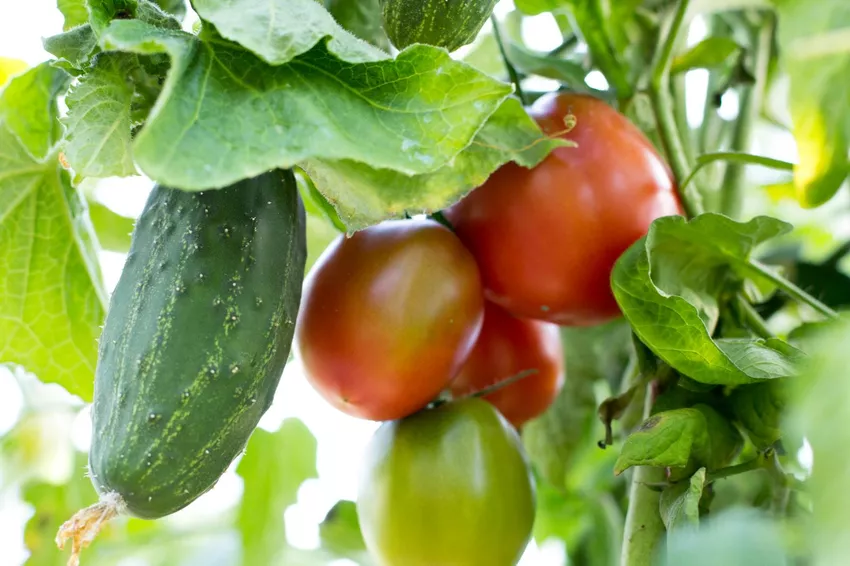Which plants get along with tomatoes? We reveal which neighbors are best planted with the delicious fruits and give tips for the perfect mixed cultivation of tomatoes.

A mixed culture is probably the most original form of vegetable cultivation, because different species grow together on one area. Whether in a bed, in a greenhouse or in a planter - different plants always come together and complement each other. Such a form of cultivation for tomatoes (Lycopersicum esculentum) not only ensures diversity on the plate, but also has very specific advantages for the plants themselves.
Advantages of intercropping tomatoes
The advantages of intercropping tomatoes over monoculture with just one vegetable are evident throughout the season:
- Mixed crops are generally more productive and significantly more diverse than individual crops.
- Various vegetation shades the soil and protects it from drying out.
- Nutrient-hungry plants next to undemanding ones prevent the soil from being leached out.
- Good neighbors protect each other from diseases and pests.
The high-growing tomato plants are therefore best placed next to low-growing vegetables that only require small amounts of nutrients. In this way, the soil is always shaded by leaves and never dries out completely, even in midsummer. The variety of plants also prevents harmful insects and diseases from spreading unchecked. In this colorful community of plants there are always members that are avoided by pests. Some even produce substances that can deter and repel pests. This also includes hot garden cress (Lepidium sativum), which keeps aphids and blood lice away from tomatoes. The partnership of convenience between tomatoes and good neighbors is a gentle way of keeping uninvited visitors away.

In addition, the vegetation of different heights protects the soil, prevents erosion by wind and heavy rain and also reduces theevaporation on hot summer days. The various root systems loosen the soil at different depths and provide food for earthworms and other soil organisms after harvest. They serve as a source of nutrients for the next plants. But what is the best way to fertilize in a mixed culture? You can't possibly supply each culture with nutrients individually. Our tip: Organic long-term fertilizers such as our Plantura organic tomato fertilizer are particularly suitable for fertilizing a mixed culture. Since the nutrients are only released slowly by the soil organisms, weak-eating vegetables can also feed on them without any problems.
What plants do tomatoes get along with?
In mixed cultivation, a wide variety of plants with different needs are grown in one bed at the same time. Here - as in real life - there are neighbors who would like to live next to each other and those who don't. In the following we present good and bad planting partners for tomatoes. For more mixed culture combinations, we recommend our special article on the best plant combinations for mixed cultures.
Good neighbors for tomatoes
Tall tomatoes are ideal for planting low, low-nutrient vegetables at their feet. Tomatoes are joined by a wide variety of salads (Lactuca sativa), spinach (Spinacia oleracea), basil (Ocimum basilicum ), chamomile (Matricaria chamomilla) and parsley (Petroselinum crispum), also popular as an early culture. This means that the herbs and vegetables are planted or sown long before the tomatoes, i.e. in March or April. Their roots loosen up the soil and thus ensure good soil conditions for the later growth of the tomato plants. They shade the ground while growing, reduce evaporation and save a lot of irrigation water, especially in summer.
Parsley (Petroselinum crispum) and basil (Ocimum basilicum) keep annoying aphids away from tomatoes with their essential oils. Carrots (Daucus carota) and parsnips (Pastinaca sativa) also use the space under the large nightshade plants, at the same time loosening the soil with their deep roots and ensure good drainage. Garden cress (Lepidium sativum) and beans (Phaseolus vulgaris), celery (Apium graveolens) as well as most Cabbages (Brassica sp.) are generally considered good neighbors for tomatoes. onions(Allium cepa), leeks (Allium ampeloprasum) and garlic (Allium sativum) are very good plant next to tomatoes, because these plant neighbors keep whiteflies (Bemisia sp.) away above ground and can even drive voles out of your bed underground. The marigold (Calendula officinalis) also stays low, keeping the annoying nematodes away and at the same time attracting pollinators to the tomatoes with its flowers.
Bad neighbors for tomatoes
However, some plants do not get along with tomatoes, for example if they make completely different demands on the location or represent competition. The natural root excretions of bad neighbors allow both partners to grow insufficiently, sometimes even stunted growth occurs. Even if nightshade plants generally get along with each other, you should avoid growing tomatoes with potatoes (Solanum tuberosum). Because the latter are almost exclusively attacked by late blight (Phytophthora infestans) and also infect the tomatoes growing nearby.
Bad neighbors for tomatoes are also other heavy consumers who have a high nutrient requirement. In the long run, this leaches out the soil and the plants suffer from deficiency symptoms.Peas (Pisum sativum) should also not be planted directly next to tomatoes, as both suffer from root exudates and the similar space requirement. Fennel (Foeniculum vulgare) and red cabbage (Brassica oleracea var.are also not good neighbors for tomatoes. capitata f. rubra).
Cucumbers (Cucumis sativus) and tomatoes are often planted together, but these plants don't get along well either - this does more harm than good to both partners. Cucumbers need a very different location than tomatoes and are easily infected with powdery mildew, which they then transmit. In extreme cases, both species grow stunted and bear little fruit.
So, with the right choice of planting neighbors for tomatoes, you can achieve quite a few positive effects - both for the vegetable itself and for the soil. But not only the neighbors of the tomatoes play an important role, but also the next tenants. That's why we've put together everything you need to know about tomato crop rotation in our special article.